Somebody's Mother NCERT Solutions | English Poorvi Class 8 - New NCERT PDF Download
Let us do these activities before we read (Page 70)
I. Recall a time you helped someone. Write two words describing: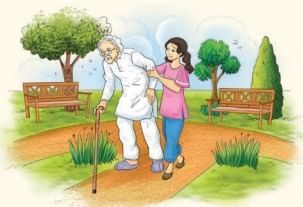 Q1: What were your feelings after you did so?
Q1: What were your feelings after you did so?
Ans: Happy, proud
Q2: What might have been the feelings of the person whom you helped?
Ans: Grateful, relieved
II. Work in pairs. Read the words given below. Circle the words you would associate with an elderly person, and underline the words you would associate with a school student. Share the reasons for your choices with your classmates and teacher Ans:
Ans: 
III. Read the lines.
The woman was old and ragged and grey
And bent with the chill of the Winter’s day.
Select the suitable meaning of ‘ragged’ as used in these lines. There are four other meanings given below. Discuss with your classmates and teacher.
1. (of clothes) old and torn; synonym: shabby
• a ragged jacket
2. Having an outline, an edge, or a surface that is not straight or even
• a ragged coastline
3. Not smooth or regular; not showing control or careful preparation
• I could hear the sound of his ragged breathing.
• Their performance was still very ragged.
4. (Informal) very tired, especially after physical effort
• The elderly man was ragged after climbing the stairs.
Ans: (of clothes) old and torn; synonym: shabby - a ragged jacket
Explanation: In this context, the word "ragged" is used to describe the woman’s appearance. She is also described as old, grey, and bent with the chill, which suggests poverty, weakness, and worn-out clothing. Therefore, “ragged” most likely refers to her wearing old and torn clothes.
Let us discuss (Page 73)
I. Arrange the events of the poem in the correct order of occurrence. Share your answers with your classmates and teacher.1. The boy returned to his friends, feeling proud of what he had done.
2. The old woman stood alone at the crossing, hesitant to move.
3. A group of schoolboys passed by, playing and laughing.
4. The boy offered to help the old woman cross the street.
5. The woman prayed for the boy who helped her.
6. The children hurried past the old woman without offering help.
7. The woman placed her hand on the boy’s arm, and he guided her safely across the street.
8. The boy thought about his own mother and hoped someone would help her one day.
Ans:
1. (2) The old woman stood alone at the crossing, hesitant to move.
2. (3) A group of schoolboys passed by, playing, and laughing.
3. (6) The children hurried past the old woman without offering help.
4. (4) The boy offered to help the old woman cross the street.
5. (7) The woman placed her hand on the boy’s arm, and he guided her safely across the street.
6. (1) The boy returned to his friends, feeling proud of what he had done.
7. (8) The boy thought about his own mother and hoped someone would help her one day.
8. (5) The woman prayed for the boy who helped her.
II. Fill in the blanks by choosing the correct answer from the options given in the brackets
1. The central theme of the poem is _____________. (kindness and empathy/adventure and courage)
Ans: The central theme of the poem is kindness and empathy.
2. The tone of the poem is _____________. (humorous and playful/sympathetic and hopeful)
Ans: The tone of the poem is sympathetic and hopeful.
3. The poem is written in couplets with _____________ lines in each stanza.(four/two)
Ans: The poem is written in couplets with two lines in each stanza.
4. The structure of the poem gives a rhythmic flow that reflects both the_____________. (narrative and emotions/story’s pace and message)
Ans: The structure of the poem gives a rhythmic flow that reflects both the narrative and emotions.
5. The poem follows a rhyme scheme of _____________. (AABB/ABAB)
Ans: The poem follows a rhyme scheme of AABB.
III. Pick examples from the poem for the following poetic devices.
1. Simile
2. Alliteration
3. Repetition
Ans:
1. Simile: “Came the boys like a flock of sheep” (compares boys to a flock of sheep using “like”).
2. Alliteration: “old and ragged and grey” (repeats the “g” sound).
3. Repetition: “Somebody’s mother” (repeated to emphasise the woman’s importance).
IV. Complete the following sentences appropriately, explaining the imagery.
1. The poem uses imagery to describe scenes of a bustling street. We know this by the phrase _______________________.
Ans: "the crowded street", which helps us imagine a busy and noisy place full of people.
2. The line ‘The street was wet with a recent snow’ suggests a cold and _______________________ weather, emphasising the woman’s helplessness.
Ans: uncomfortable
V. Complete the following sentence with a suitable reason.
The poet repeats the phrase Somebody’s mother because it_______________________.
Ans: reminds us that the old woman is also a loved and cared-for person, deserving kindness and respect, just like anyone else's mother.
VI. Complete the analogy:
The old woman: vulnerable and neglected:: The young boy:_______________________.
Ans: kind and compassionate.
Let us think and reflect (Page 74)
I. Read the given extracts and answer the questions that follow.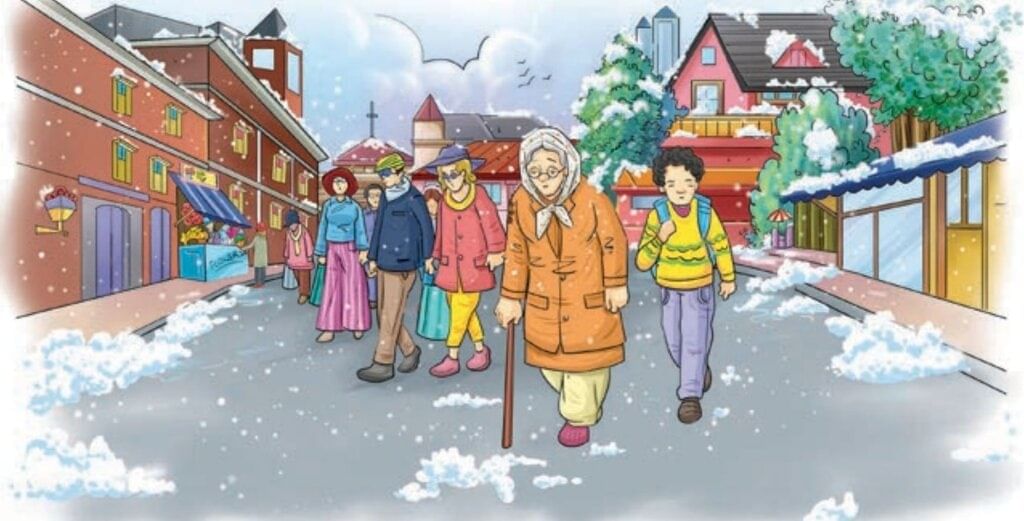
1. The woman was old and ragged and grey
And bent with the chill of the Winter’s day.
The street was wet with recent snow
And the woman’s feet were aged and slow.
(i) What does the phrase ‘ragged and grey’ refer to?
A. The woman’s emotional state that day.
B. The woman’s old and worn-out appearance.
C. The weather conditions of the particular day.
D. The colour of the street and the surroundings.
Ans: B. The woman’s old and worn-out appearance.
(ii) Complete the following sentence with a suitable reason:
The woman was ‘bent’ with the chill of the Winter’s day because she was _______________________.
Ans: old and weak, and the cold made her hunch over.
(iii) Identify the fact and opinion from the following sentences:
A. The street was wet with recent snow. _______________________
B. The woman was too weak to cross the street on her own._______________________
Ans: A. Fact – describes an observable condition
B. Opinion – assumes her weakness
(iv) Why do you think the woman’s feet were described as ‘aged and slow’?
Ans: This doesn’t directly answer the question. The correct idea is about the woman’s weakness.
2. He guided the trembling feet along,
Proud that his own were firm and strong.
Then back again to his friends he went,
His young heart happy and well content.
(i) What does the contrast between the ‘trembling feet’ of the old woman and the ‘firm and strong’ feet of the boy emphasise?
Ans: The difference in their age and physical strength showing the boy’s ability to help her.
(ii) Fill in the blank given below by selecting the correct option from the brackets.
• The poem tells us that the boy was ‘proud’ that his feet were strong.
• This tells us that the boy was ________. (arrogant about being strong/grateful for his ability to help)
Ans: The poem tells us that the boy was “proud” that his feet were strong.
(iii) What is the boy most likely to tell his friends on getting back?
A. I’m so glad I could help her.
B. I’m worried about her safety.
C. I’m surprised she forgot to thank me.
D. I’m thankful for all your support.
Ans: A. I’m so glad I could help her.
(iv) Rectify the false sentence given below.
The young boy’s actions were driven by a logical decision.
Ans: The young boy’s actions were driven by kindness and empathy.
II Answer the following questions.
1. What might be the old woman’s fears as she waited for a long time at the crossing?
Ans: She might have feared falling, being hit by carriages or horses, or being ignored in the slippery street.
2. How does the poet show the helplessness of the old woman? Support your answer with evidence from the poem.
Ans: The poet shows her helplessness by describing her as “old and ragged and grey,” “bent with the chill,” and having “aged and slow” feet. The lines “She stood at the crossing and waited long, / Alone, uncared for” show she was ignored and afraid to move.
3. Why does the boy decide to help the old woman? What does this tell us about him?
Ans: The boy helps because he feels empathy, thinking of his mother. This shows he is kind, caring, and respectful.
4. How was the boy’s approach towards the old woman different from that of the other boys in the group?
Ans: The other boys hurried past without helping, while the boy stopped, offered help, and guided her safely, showing kindness.
5. Justify the appropriateness of the title of the poem.
Ans: The title “Somebody’s Mother” is appropriate because it emphasises the woman’s value as a loved mother, inspiring the boy’s kindness and her prayer for him.
6. What does the poem suggest about the role of empathy and humanity in society?
Ans: The poem suggests that empathy and humanity, like helping others, make society kinder and show that everyone deserves care and respect.
Let us learn (Page 76)
I. The grid given below has the antonyms of the words from the text. Locate these words in the grid horizontally, vertically, and diagonally. One example has been done for you. You may refer to a dictionary.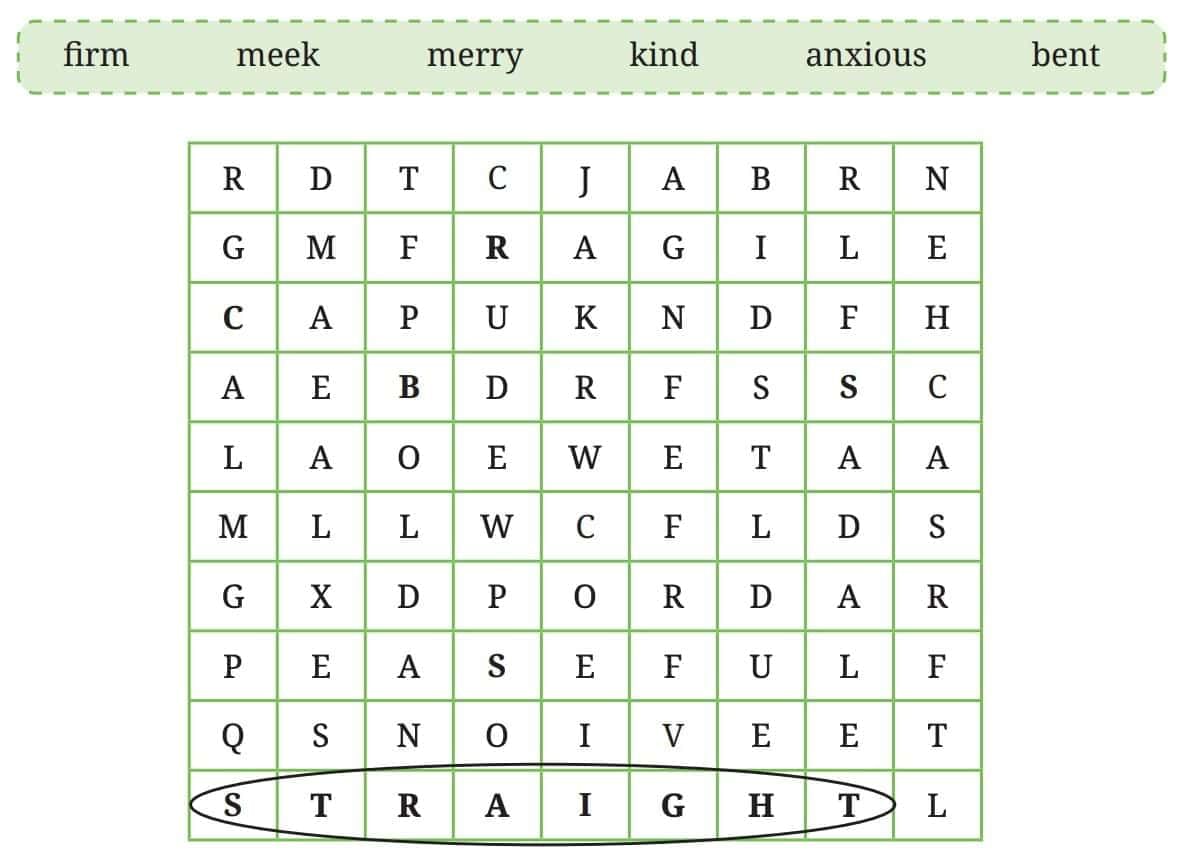
Ans: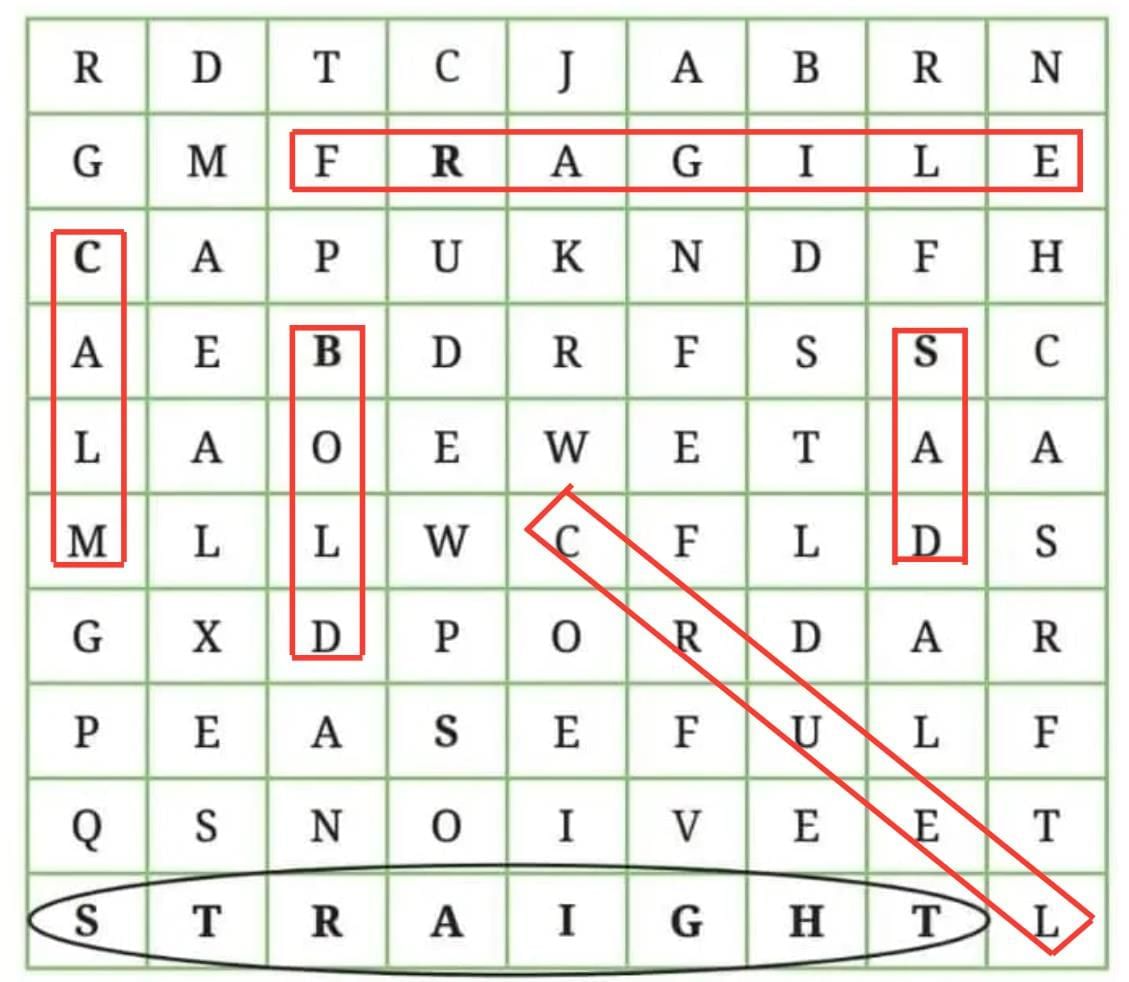
II. Match the words from the text given in Column 1 with the underlined phrases in Column 2.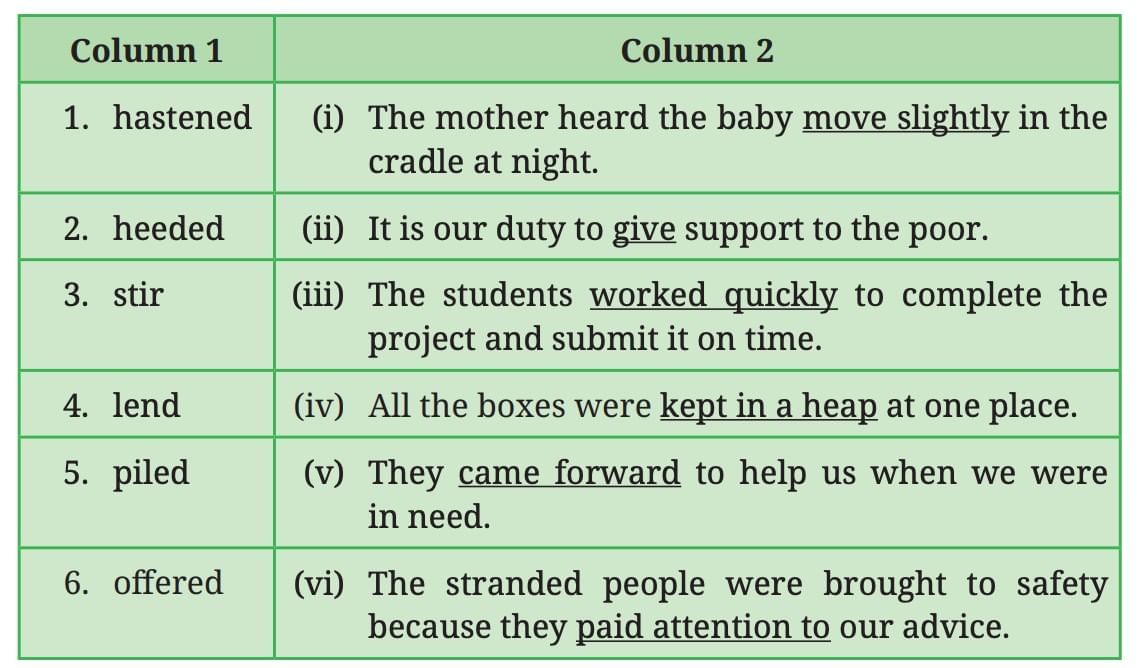 Ans:
Ans:
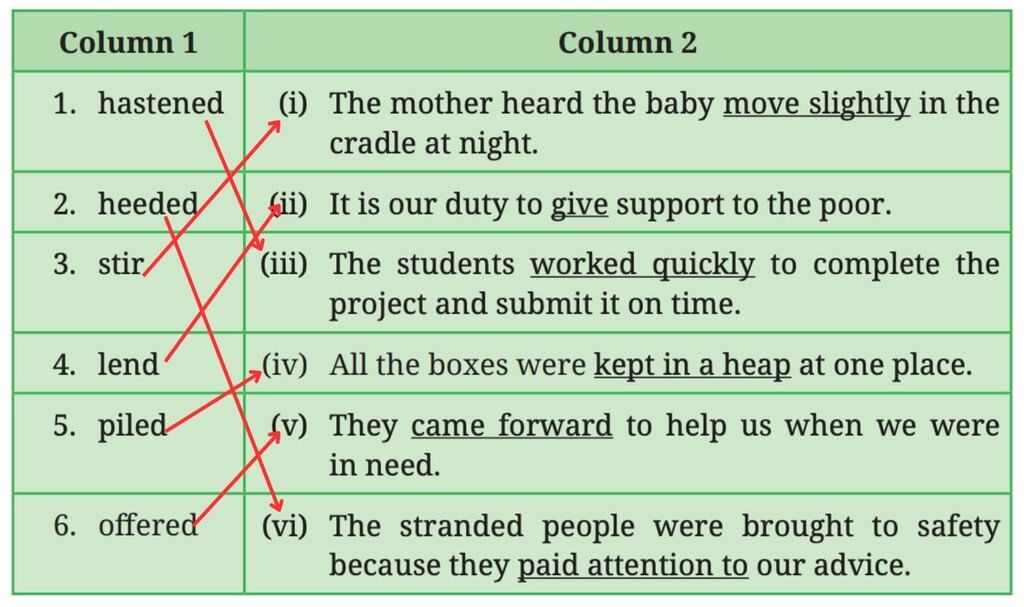
III. In the poem, the poet uses the idiom ‘lend a hand’, which means ‘help somebody’. Some more idioms using ‘hand’ are given in Column 1. Match these idioms with their meanings in Column 2. You may refer to a dictionary.
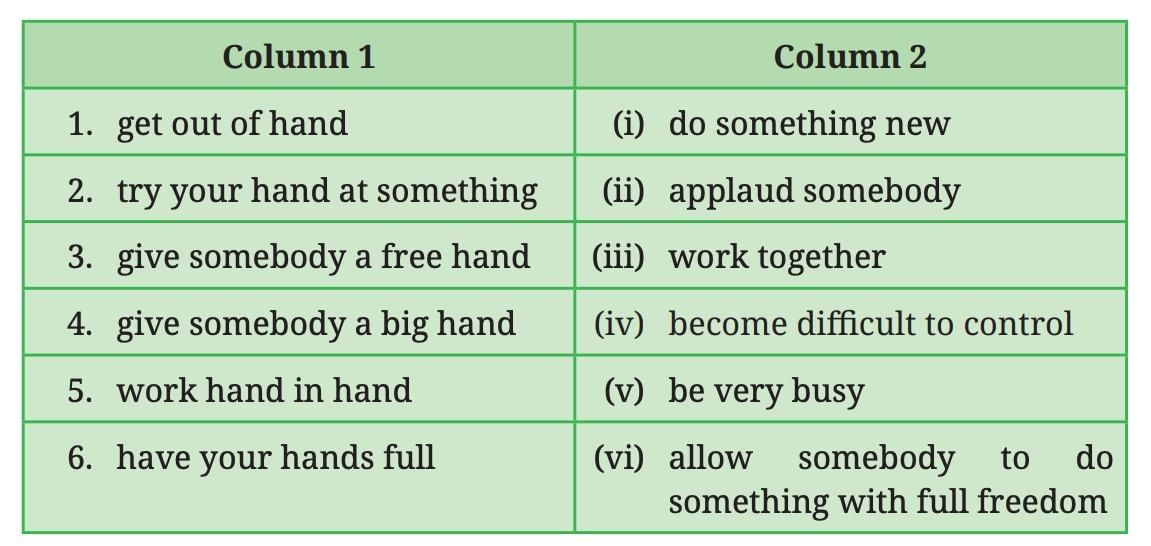 Ans:
Ans:
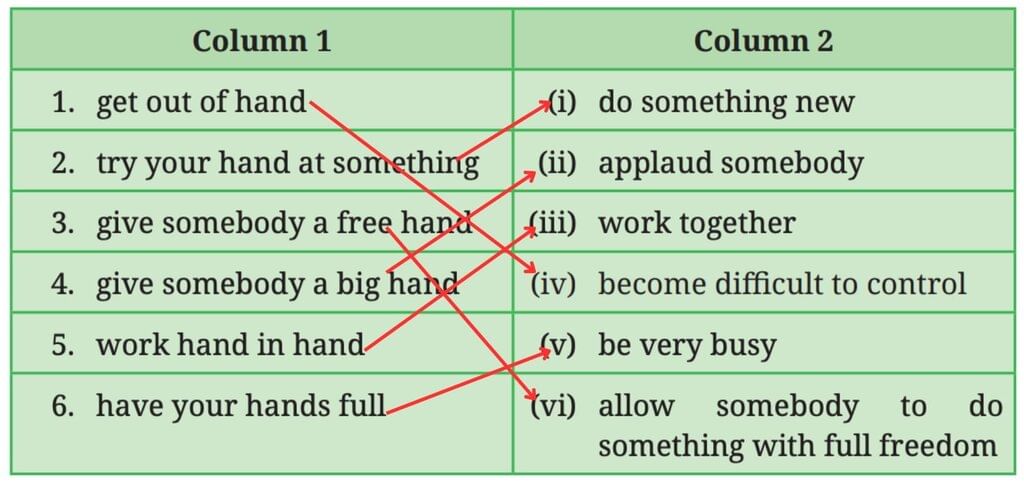
IV. Complete the following analogy by filling in the blanks with the correct words from the poem.
1. ___________ : winter :: heat : summer
2. hurt : ___________ :: old: aged
3. whispered : shouted:: humble: ___________
4. eyes : ___________ :: legs : walk
5. having a lot of money: wealthy:: densely packed people: ___________
Ans:
- cold : winter :: heat : summer
- hurt : harm :: old : aged
- whispered : shouted :: humble : proud
- eyes : see :: legs : walk
- having a lot of money : wealthy :: densely packed people : crowded
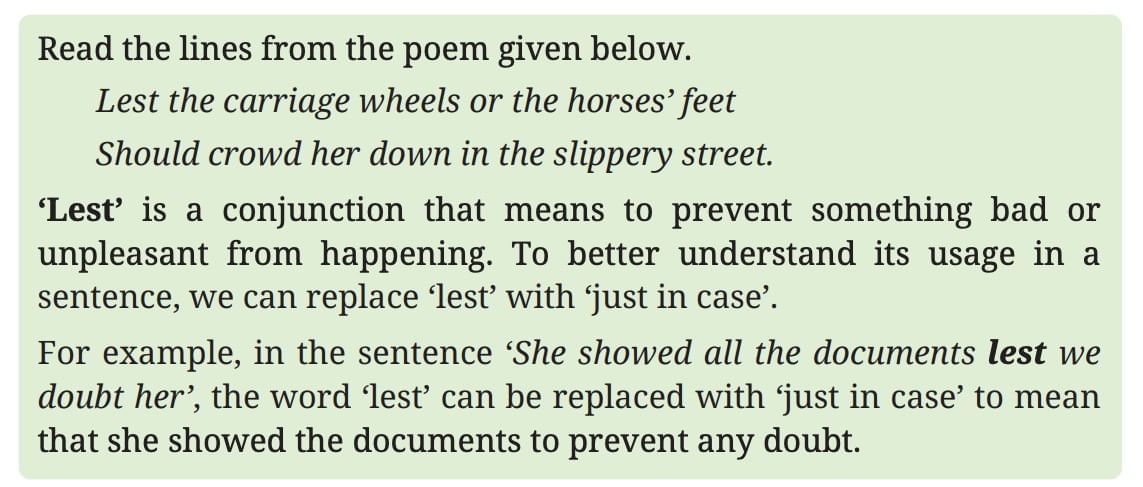
Let Us listen (Page 78)
I. You will listen to a woman read the special broadcast of the news. As you listen, arrange the pictures in the correct sequence of the events that took place.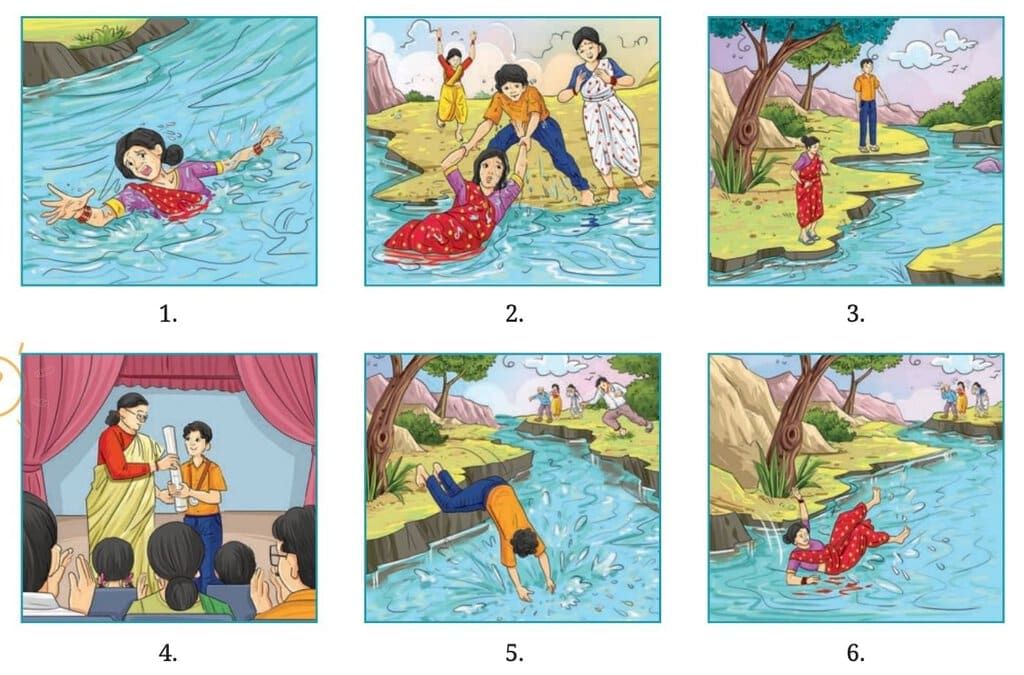 Ans: 3 → 6 → 1 → 5 → 2 → 4
Ans: 3 → 6 → 1 → 5 → 2 → 4II. You will once again listen to the special broadcast of the news. As you listen, complete the following
sentences with one to three exact words.
1. The woman was having a difficult time staying afloat due to the_________________.
Ans: strong currents
2. Rohan leapt into the river to save the woman without any_________________.
Ans: hesitation
3. Rohan’s act of bravery was witnessed by _________________.
Ans: several onlookers
4. Rohan was honoured at the Vigyan Bhawan for his incredible courage and _________________.
Ans: selflessness
5. Rohan proved that when it comes to saving lives, age is_________________.
Ans: just a number
Let us speak (Page 79)
I. Read aloud the list of words from the poem that end in ‘-ed’. As you read, focus on the final sound of each word and place them in the appropriate columns. One example has been done for you.
Ans: This is a classroom activity. Read the words and sort them by their “-ed” sound. Example:
/t/ sound: helped, passed, placed
/d/ sound: guided, hailed, bowed
/ɪd/ sound: waited, contented
II. Work in pairs. Narrate an incident where you helped someone in the past. Take turns to speak and use the cue cards given below.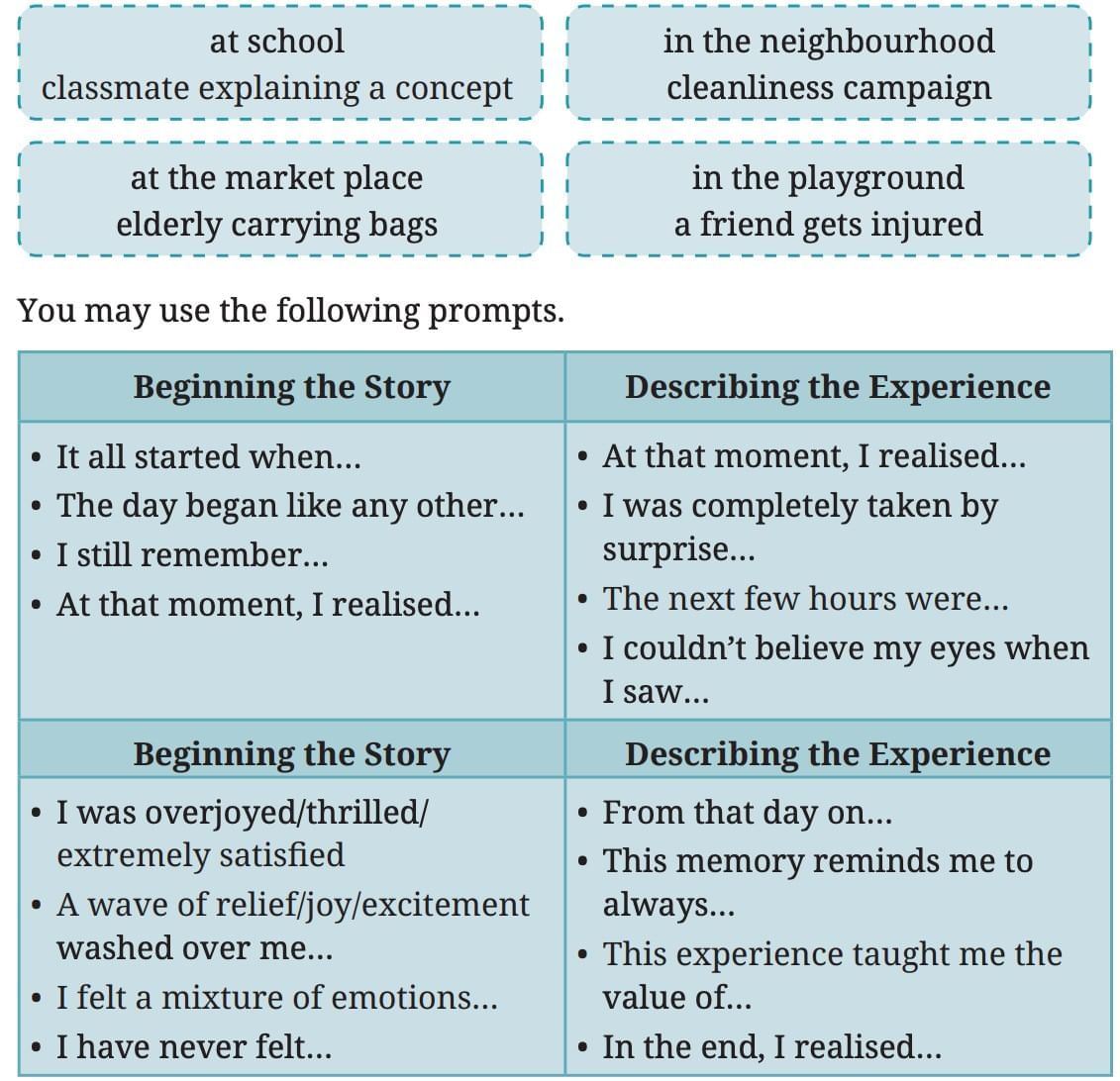
Let us write (Page 80)
I. Write a diary entry of a day you helped someone in need. Remember to include the following points while writing it.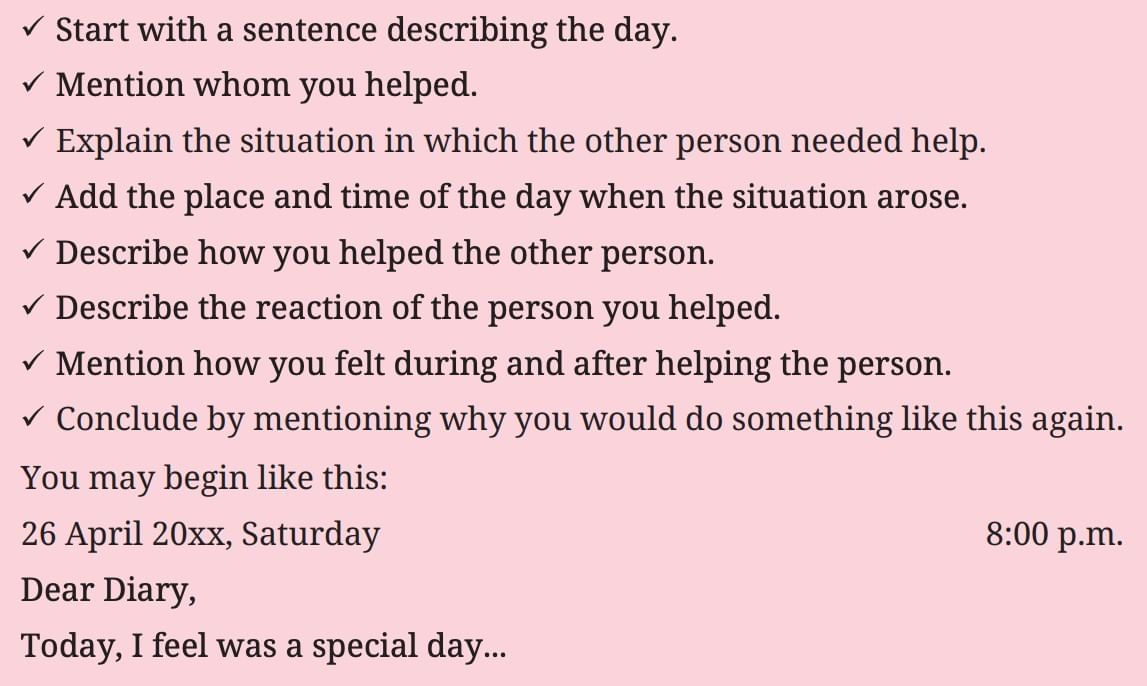 Ans:
Ans:26 April 2025, Saturday
8:00 p.m.
Dear Diary,
Today was a special day because I helped an elderly neighbour, Mrs. Sharma. In the afternoon, at around 2:00 p.m., I saw her struggling to carry heavy grocery bags near our apartment gate. She looked tired and was moving slowly. I offered to carry her bags to her house on the second floor. She smiled and thanked me warmly, saying she felt relieved. I felt happy and proud while helping her, and afterwards, I felt joyful knowing I made her day easier. I would help again because it feels good to be kind and make someone smile.
Yours,
[Your Name]
Let us explore (Page 80)
I. Did you know that even Earth has been referred to as mother in the ancient scriptures of India? In section 12.1.12 of Pṛthvi-Sūkta (hymn to the earth) of Atharva Veda, Earth is referred to as mother and us as her children by stating:
II. Work in groups of four. Find out the names of countries that refer to their country as ‘motherland’ and a few others as ‘fatherland’. Share your findings with your classmates and teacher.
Ans: Motherland: India, Russia, Bangladesh
Fatherland: Germany, Norway, Iceland
III. Read the poem and enjoy.
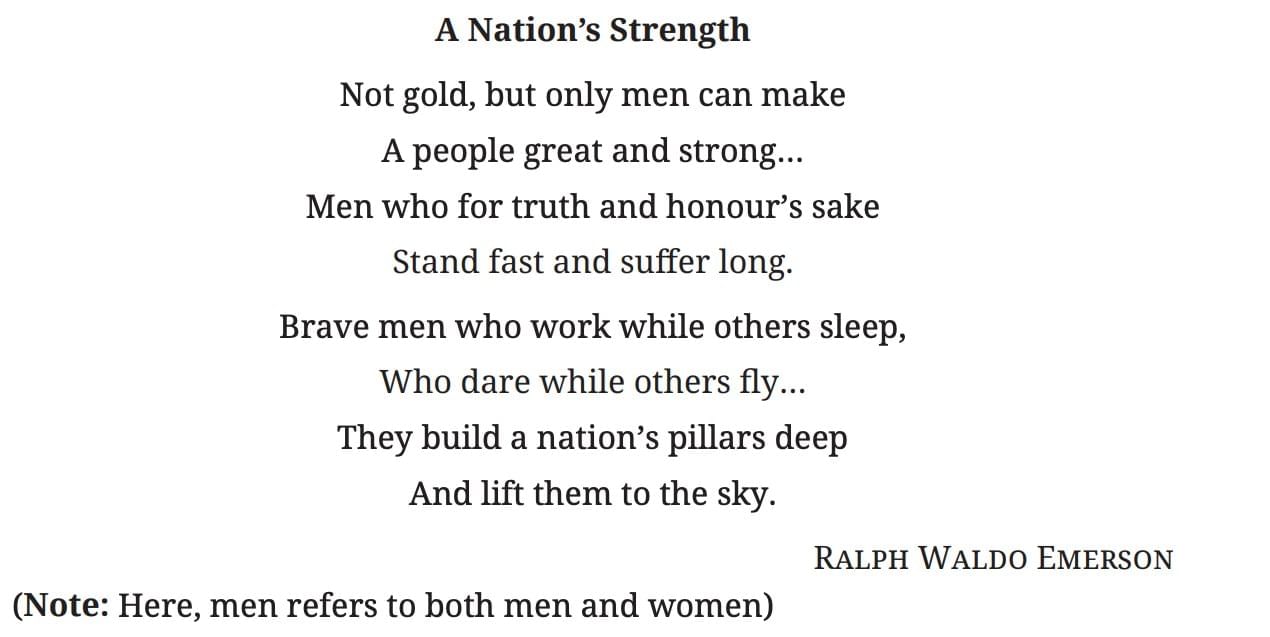
IV. Make a gratitude card for your mother/grandmother to thank her for at least five things that she does for you. Also write two things that you would do regularly to help them. Use recycled material to make and decorate the card.

Ans: Example Response

|
60 videos|520 docs|57 tests
|
FAQs on Somebody's Mother NCERT Solutions - English Poorvi Class 8 - New NCERT
| 1. What is the main theme of the poem "Somebody's Mother"? |  |
| 2. How does the poet depict the relationship between the young boy and the old woman? |  |
| 3. What literary devices are used in "Somebody's Mother"? |  |
| 4. What message does the poem convey about societal attitudes towards the elderly? |  |
| 5. How does the ending of the poem impact its overall meaning? |  |

















